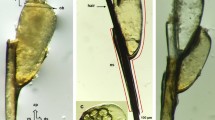Abstract
Lipophorin was isolated from the stalk borer, Busseola fusca, larvae by ultracentrifugation in a KBr density-gradient. The lipophorin ( Mr ~ 700,000) is a high density lipoprotein (density = 1.13 g/ml) composed of 46% lipids and 4% carbohydrates. It consists of two apoproteins, apolipophorin-I (apoLp-I, Mr ~ 210,000) and apolipophorin-II (apoLp-II, Mr ~78,000). Both apoproteins are glycosylated as shown by periodate Schiff reagent staining and binding to the lectin, concanavalin A. Amino acid composition analysis of lipophorin showed predominance of aspartate (13%), glutamate (9%) and glycine (9%).
In an immunoblotting experiment, both apoproteins showed immunoreactivity with antiserum to B. fusca lipophorin and no cross-reactivity occurred with any other haemolvmph proteins. Immunodiffusion studies with the same antibodies showed cross-reactivity with haemolymph derived from other Lepidoptera and not from Orthoptera, Dictyoptera or Diptera.
Résumé
Une lipophorine a été isolée des larves de Busseola fusca, par ultracentrifugation avec gradient de densité. La lipophorine dont le poids moléculaire est d’environ ~700,000 est une lipoprotéine de densité élevée (1.13 mg/ml) composée de 46% de lipides et de 4% de glucides. La lipophorine comporte 2 apoprotéines: l’apolipophorine-I (apoLp-I, de poids moléculaire environ ~210,000) et l’apolipophorine-II (apoLp-II, de poids moléculaire ~78,000). Les deux apoprotéines sont glycosylées comme le démontre la coloration au réactif du périodate de Schiff (PAS). La présence de manose comportant des chaines d’oligosaccharides a été établie par la réaction d’attachement de la lipophorine à la concanavaline-A sur colonne de sépharose. L’analyse de la composition en acides aminés de la lipophorine montre une prédominance d’aspartate (13%), de glutamate (9%) et de glycine (9%). Au cours de tests d’immunoblotting, les antisera des deux apoprotéines de la lipophorine ont réagi avec les anticorps. Nos résultats suggèrent également que les lipophorines d’insectes du même ordre développeraient une cross réaction.
Similar content being viewed by others
References
Bartlett G. J. (1959) Phosphorus assay in column chromatography. J. Biol.Chem., 234, 246–268.
Bligh E. A. and Dyer W. J. (1959) A rapid method of total lipid extraction and purification. Can. J. Biochem. Physiol. 37, 911–917.
Burnette W. W. (1981) “Western blotting”: electrophoretic transfer of proteins from sodium dodecyl sulphate Polyacrylamide gels to unmodified nitrocellulose and radiographic detection with antibody and radioiodinated protein A. Anal. Biochem. 112, 195–203.
Chino H. and Kitazawa K. (1981) Diacylglycerol-carrying lipoprotein of haemolymph of the locust and some insects. J. Lipid Res. 22, 1042–1052.
Dubois M., Gilles K. A., Hamilton J. K., Rebers P. A. and Smith F. (1956) Colorimetric method for determination of sugars and related substances. Anal. Chem. 28, 350–356.
De Kort C. A. D. and Koopmanschap A. B. (1987) Molecular characteristics of lipophorin, the juvenile hormone binding protein in the haemolymph of the Colorado potato beetle. Arch. Insect Biochem. Physiol. 5, 255–269.
Haunerland N. H. and Bowers W. S. (1986) Binding of insecticides to lipophorin and arylphorin, two haemolymph proteins of Heliothis zea. Arch. Biochem. Physiol. 3, 87–96.
Haunerland N. H. and Bowers WS. (1989) Comparative studies on arthropod lipoproteins. Comp. Biochem. Physiol. 92 B, 137–141.
Kapitany R. A. and Zebrowski E. J. (1973) A high resolution PAS stain for Polyacrylamide gel. Anal. Biochem. 56, 361–369.
Kanost M. R., Kawooya J. K., Law J. H., Ryan R. O., Van Heusden M. C. and Ziegler R. (1990) Insect haemolymph proteins. Adv. Insect Physiol. 22, 299–396.
Laemmli U. K. (1970) Cleavage of structural protein during the assembly of the heads of Bacteriophage T. Nature 227, 680–685.
Ouchterlony O. (1968) Antibody reaction in gels. In Handbook of Immunodiffusion and Immunoelectrophoresis. Ann Arbor Science Publishers, Ann Arbor, Michigan.
Osir E. O., Anderson D. R., Grimes W. J. and Law J. H. (1986) Studies on the carbohydrate moiety of vitellogenin from the tobacco hornworm, Manduca sexta. Insect Biochem. 16, 471–478.
Osir E. O., Labongo L. V. and Unnithan G. C. (1989) A high molecular weight diapause-associated protein from the stem-borer, Busseola fusca: Purification andiproperties. Arch. Insect Biochem. Physiol. 11, 173–187.
Osir E. O., Unnithan G. C., and Prestwich G. D. (1991) Juvenile hormone binding to a 500 K diapause-associated protein of the stem-borer, Busseola fusca. Comp. Biochem. Physiol. 99B, 165–169.
Robbs S. L., Ryan R. O., Schmidt J. O., Keim P. S. and Law J. H. (1985) Lipophorin of the larval honeybee, Apis mellifera. J. Lipid Res. 26, 241–247.
Ryan R. O., Schmidt J. O. and Law J. H. (1984) Chemical and immunological properties of lipophorins from seven insect orders. Arch. Insect Biochem. Physiol. 15, 375–384.
Ryan R. O., Prasad S.V., Henrickson E. J., Wells M. A. and Law J. H. (1986) Lipoprotein interconversions in an insect, Manduca sexta. Evidence for a lipid transfer factor in the hemolymph. J. Biol. Chem. 261, 563–568.
Shapiro J. P., Law J. H. and Wells M. A. (1988) Lipid transport in insects. Annu. Rev. Entomol. 33, 297–318.
Shapiro J. P., Keim P. S. and Law J. H. (1984) Structural studies on lipophorin, an insect lipoprotein. J. Biol. Chem. 259, 3680–3685.
Shapiro J. P. and Law J. H. (1983) Locust adipokinetic hormone stimulates lipid metabolism in Manduca sexta. Biochem, Biophys. Res. Commun. 115, 929–931.
Shapiro J. P. (1988) Isolation and fluorescence studies on lipophorin from the weevil, Diaprepes abbreviatus. Arch. Insect Biochem. Physiol. 7, 119–131.
Unnithan G. C. (1987) Development and reproductive biology of the maize stem borer, Busseola fusca (Fuller) (Lepid., Noctuidae). J. Appl. Entomol. 104, 172–177.
Wells M. A., Ryan R. O., Prasad S. V. and Law J. H. (1985) A novel procedure for the purification of polipophorin III. Insect Biochem. 15, 565–571.
Author information
Authors and Affiliations
Rights and permissions
About this article
Cite this article
Ogoyi, D.O., Osir, E.O. & Ochanda, J.O. Ophorin of the Larval Stalk Borer, Busseola Fusca: Purification and Properties. Int J Trop Insect Sci 14, 167–172 (1993). https://doi.org/10.1017/S1742758400014569
Received:
Accepted:
Published:
Issue Date:
DOI: https://doi.org/10.1017/S1742758400014569




